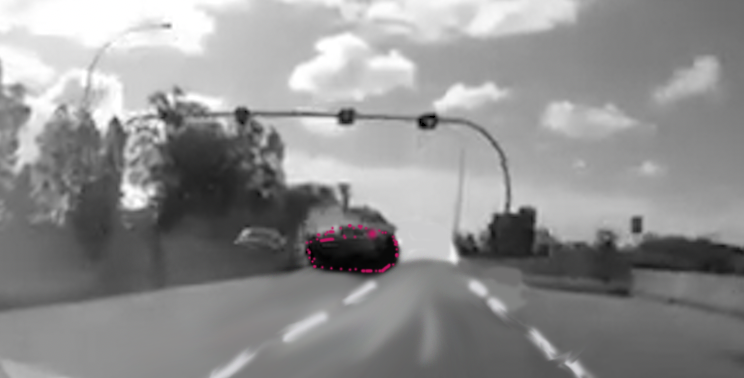- The car ahead swerved and avoided the hit. @:008
- The driver ahead SLOWS down @007 and SWERVES @008 right before the hazard passes him.
- If you look closely @007 you are gaining ground on the car ahead of you compared to earlier. The car ahead is either braking or lifting off his accelerator.
- Notice the space, the lane, to the right of us is clear. @004 to crash@009
- We remain straight in our lane. We do not move at all.
- Notice we are following one second from the car ahead.
- It takes the danger car one second to get to us. @007 to crash@009
- Left lane beside us is clear and holds a clean open view.
- There is something on the dash reflecting off the windshield stealing away some of our clear vision.
1. How did the front car, closest to the danger, swerve when the car we were in, which was further away from the danger, didn’t move at all and was hit?
2. We don’t slow down? Why?
3. We are following 1 second from ahead ca which is illegal. It should be 2 plus. Is this 1-second following distance a habit?
4. Are objects on the dash another habit that regularly creates a reflection on the windshield stealing valuable vision clarity?
5. We don’t seem to react to the coming danger at all.
Before continuing, replay the video several times to ensure that you AGREE and CAN SEE the visual truth of the above statements. Stopping the video at the exact times will help.
Our visual habit in this incident is to follow the car ahead of us filling our brain and vision with the activity of that one car, one second ahead of us. This very strong, many years relaxed habit, is comfortable allowing for our attention on the space 3 to 5 car lengths ahead of us.
But this hazard comes at us from 15 to 20 or more car lengths away at a slight angle to the left of us, not from straight ahead. It advances towards us from over double our scanning distance in 1 second.
Our driver did not see the hazard. Certainly not in enough time to move or brake. Our car stayed straight on, with no change until hit, yet the car ahead which was closer swerved. We did not move. WHY? What were we looking at? Or what were we NOT looking at?
Research repeatedly says you must hold 2 to 3 seconds ahead to give yourself enough time to react. I convert this to a looking-ahead-habit of 20 30 40 car lengths forward.
VISION HABIT: five to 8 car lengths ahead
SUGGESTED VISION HABIT: 20 to 30 to 40+ car lengths head
Imagine no car ahead of you leaving only the large spinning hazard. Would this give you a better chance of moving? Of course, it would. But drivers who follow other drivers rarely have nothing in front of them. They are familiar with following, not leading into open safe space.

PLUS nothing on the dash, please. Your need maximum vision always – a perfectly clean dash preventing all reflections.
But drivers who follow other drivers rarely have nothing in front of them.
They are familiar with following, not leading into open safe space.
Just watch the next tailgater behind you. After they pass you, zooom, they race up to stare at the back of the next car – A HABIT!
so maybe the real danger here, is you





Comments are closed